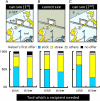Chimpanzees' flexible targeted helping based on an understanding of conspecifics' goals
- PMID: 22315399
- PMCID: PMC3295314
- DOI: 10.1073/pnas.1108517109
Chimpanzees' flexible targeted helping based on an understanding of conspecifics' goals
Abstract
Humans extensively help others altruistically, which plays an important role in maintaining cooperative societies. Although some nonhuman animals are also capable of helping others altruistically, humans are considered unique in our voluntary helping and our variety of helping behaviors. Many still believe that this is because only humans can understand others' goals due to our unique "theory of mind" abilities, especially shared intentionality. However, we know little of the cognitive mechanisms underlying helping in nonhuman animals, especially if and how they understand others' goals. The present study provides the empirical evidence for flexible targeted helping depending on conspecifics' needs in chimpanzees. The subjects of this study selected an appropriate tool from a random set of seven objects to transfer to a conspecific partner confronted with differing tool-use situations, indicating that they understood what their partner needed. This targeted helping, (i.e., selecting the appropriate tool to transfer), was observed only when the helpers could visually assess their partner's situation. If visual access was obstructed, the chimpanzees still tried to help their partner upon request, but failed to select and donate the appropriate tool needed by their partner. These results suggest that the limitation in chimpanzees' voluntary helping is not necessarily due to failure in understanding others' goals. Chimpanzees can understand conspecifics' goals and demonstrate cognitively advanced targeted helping as long as they are able to visually evaluate their conspecifics' predicament. However, they will seldom help others without direct request for help.
Conflict of interest statement
The authors declare no conflict of interest.
Figures



References
-
- de Waal FBM. Good Natured. Cambridge, MA: Harvard University Press; 1996.
-
- Dugatkin LA. Cooperation Among Animals: An Evolutionary Perspective. Oxford: Oxford University Press; 1997.
-
- Kappeler PM, van Schaik CP. Cooperation in Primates and Humans: Mechanisms and Evolution. Springer, London; New York: Berlin; Heidelberg; 2006.

